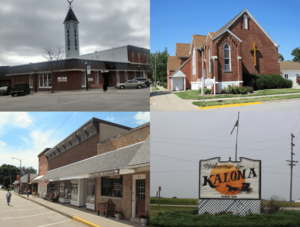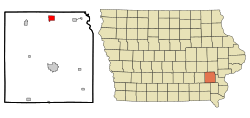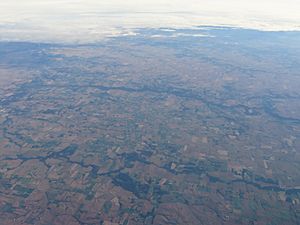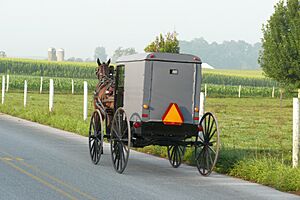Kalona, Iowa facts for kids
Quick facts for kids
Kalona, Iowa
|
|
|---|---|

Left column: Downtown Kalona
Right column: Kalona United Methodist Church, Kalona Welcome Sign |
|
| Nickname(s):
Quilt Capitol of Iowa
|
|

Location of Kalona, Iowa
|
|
| Country | |
| State | |
| County | Washington |
| Area | |
| • Total | 2.15 sq mi (5.57 km2) |
| • Land | 2.15 sq mi (5.57 km2) |
| • Water | 0.00 sq mi (0.00 km2) |
| Elevation | 666 ft (203 m) |
| Population
(2020)
|
|
| • Total | 2,630 |
| • Density | 1,220.42/sq mi (471.24/km2) |
| Time zone | UTC-6 (Central (CST)) |
| • Summer (DST) | UTC-5 (CDT) |
| ZIP code |
52247
|
| Area code(s) | 319 |
| FIPS code | 19-40170 |
| GNIS feature ID | 2395485 |
Kalona is a city in Washington County, Iowa. It is part of the Iowa City metropolitan area. In 2020, about 2,630 people lived there. Kalona is the second-largest city in Washington County. It is known for its crafts, antiques, and local products.
Contents
History of Kalona
The first Amish settlers came to the Kalona area in the 1840s. They were among the first European people to settle here. Over time, different groups of Amish formed.
In 1879, a railroad was built through the area. The city of Kalona was officially started on August 6, 1879. A man named Mr. Myers suggested the name "Kalona" after his bull. The town became an official city in 1890.
Today, Kalona is a growing city. Many people visit its local shops and restaurants. The city's old downtown area is very popular with tourists.
Geography of Kalona
Kalona is located in Iowa. The city covers an area of about 2.15 square miles (5.57 square kilometers). All of this area is land.
People of Kalona
In 2020, the city of Kalona had 2,630 residents. There were 1,110 households in the city. Most of the people living in Kalona are White. About 5.2% of the population was Hispanic or Latino.
The average age of people in Kalona was 43.2 years old. About 25.4% of the residents were under 20 years old. Also, 24.8% were 65 years old or older. The city has a slightly higher number of females than males.
Culture and Community
Near Kalona, you can find one of the largest Amish communities west of the Mississippi. This community has about 1,200 people and is the oldest Amish settlement in Iowa, started in 1846. The Amish here are more open to using some modern technology, like tractors for farm work.
Kalona is also home to the Iowa Mennonite Archives. These archives are located at the Kalona Historical Village. They keep important records about the Mennonite people. The Iowa Mennonite School is also located a few miles northwest of Kalona.
Education in Kalona
The Mid-Prairie Community School District is in charge of the public schools in the Kalona area.
See also
 In Spanish: Kalona para niños
In Spanish: Kalona para niños



